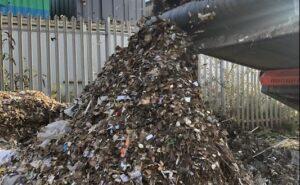QED for Trommel Fines
What are Trommel Fines?
Trommel fines are residuals generated after separating out the larger materials such as stone, concrete and rebar from construction waste. Particle sizes are generally below 40mm. Trommel fines from construction sites or general waste skips often contain materials such as insulation materials, plastic films, rigid plastics, vegetation, wood, glass, metal and textiles. They can also be contaminated with heavy metals, petroleum hydrocarbons and asbestos.
Trommel fines can be treated to recover other fractions for use in soil production or sand recovery. There are various treatment methods such as washing which can recover the useful material and minimise the quantity of unusable material which is sent to landfill.
Trommel fines have traditionally, but incorrectly, been assumed to be non hazardous or even inert. WM3 guidance is very clear that as a waste, the trommel fines require classification. Trommel fines and any materials produced from the treatment of trommel fines must be tested for TPH, heavy metals, asbestos, sulphate and total organic carbon (TOC) at the minimum. Heavy metals at hazardous concentrations are rare, but putting glazed pottery through a trommel may cause the glaze, which is often high in Lead, Arsenic and Chromium to be left in the fines. Sulphate from gypsum in plasterboard can be a problem. Asbestos is usually visual – can you see chunks of asbestos containing material (ACM.) ACM is usually asbestos/cement sheeting or tiles. Artex ceilings can also contain asbestos.
Many sites produce trommel fines from stockpiles of excavated material that have come from different parts of a site or are from skips brought in from several sites. Analysis results from site investigations or a general assumption that the original material is “clean” are not valid for classifying waste using WM3 guidance. WM3 specifies the number of samples that should be analysed for a particular type of waste, especially if the source of that waste is as variable as construction waste.
Testing Fines
The Loss on Ignition (LOI) test estimates the amount of organic carbon that could possibly be converted to methane. A concentration of organic compounds with high sulphate present causes the production of very smelly hydrogen sulphide. If the fines are to be sent for landfill, they must meet the LOI threshold of 10 % or less to qualify for the lower rate of landfill tax of (currently) £3.15 per tonne. An LOI result of over 10% will mean that the fines are classified as hazardous and charged at the higher rate of £98.60 per tonne for landfill (as of 2023.)
It’s very important to ensure that trommel fines are correctly classified to ensure that you are not paying the wrong rate of landfill tax, or worse, breaching Section 34 of the Environmental Protection Act 1990 which would have very serious consequences. Waste sent to landfill must be have undergone basic characterisation or compliance testing.
Testing doesn’t need to be expensive
Laboratory analysis, unless it’s of top quality and therefore very expensive, frequently misclassifies fines as hazardous with a high TPH value, when in fact they contain no actual TPH. The TPH value is often due to vegetation, bitumen based products or microplastics created by the decomposition of insulation materials and other plastics. These materials as well as small pieces of wood can give a high LOI or TOC. Insulation, bitumen and microplastics will not decompose to generate methane and are essentially inert.
Fast, low cost results you can rely on
The QED screens out these non-hazardous materials, and so gives you a true picture of the petroleum hydrocarbon contamination in waste material. .It also gives a total 16 PAHs and BaP concentration. The SciAps XRF, also from QROS, gives results for toxic heavy metals and can also detect the lighter elements such as Ca, Mg, Al, Sulphur and Chlorine, which can be useful for Sulphate estimations. Asbestos in ACM is readily detected by a competent and trained operator.
The QED and XRF analysers can be used on site with the minimum of training. At a very low cost per sample , you can get results for both petroleum hydrocarbons, heavy metals and sulphur, all within four minutes, meaning material can be readily identified and your site competently managed. If you are complying with the WM3 requirements for the number of tests, the analysers will pay for themselves very quickly.
The use of on site analysis methods such as the QED and XRF allows rapid and cost effective analysis of the number of samples needed to confirm the hazard classification and to continue to prove the waste classification has not changed. On a busy site, it is easy to miss contaminated soil coming in that should not be processed. The use of rapid analysis methods increases the confidence in the validity of the waste classification, helps to achieve compliance and ensures inappropriate material is not processed or shipped off site.
Accepted by the Environment Agency
QED and XRF results are widely accepted by waste processors, landfill operatives and the Environment Agency due to the robustness of their data and the cost saving they allow, see: EA and On Site Analysis – QROS – Quality Results Fast